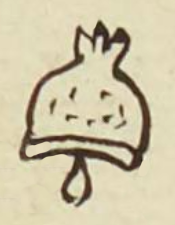Tzitzil (MH591v)
This black-line drawing of the simplex glyph for the personal name Tzitzil (“Bell,” attested here as a man’s name) shows a bell with a tripartite handle at the top, some dots on the body of the bell, a horizontal line near the bottom, and a clapper protruding at the bottom.
Stephanie Wood
This type of European bell was a point of pride for some towns to acquire for their new temples, the Christian churches. The autonomous-era type of bells (coyolli), as shown on folio 44 recto of the Codex Mendoza (see below) has little sound scrolls coming out of the bottom. The coyolli (jingle bells) and oyohualli (also shown below) were usually small copper or gold bells. The loop at the top of this bell does coincide with the loop of some of the coyolli bells, which could hang from jewelry or from a leather thong around ankles, for instance, when danced. Juan José Batalla Rosado (2018, 96) includes the various glyphs related to the verbs tzilini/tzizlinia in his study of visual loans, given that the iconography of these bells has been greatly influenced by exposure to European bells. He also points to the new occupation of bell ringer and its seeming neologisms tlatzilini or tlatziliniani (2018, 97).
Stephanie Wood
diego tzintzil
Diego Tzitzil
Stephanie Wood
1560
Jeff Haskett-Wood
bells, campanas, music, música, suena, metales, nombres de hombres

tzitzil(li), bell, https://nahuatl.wired-humanities.org/content/tzitzilli
La Campana
Stephanie Wood
Matrícula de Huexotzinco, folio 591v, https://www.loc.gov/resource/gdcwdl.wdl_15282/?sp=262&st=image
This manuscript is hosted by the Library of Congress and the World Digital Library; used here with the Creative Commons, “Attribution-NonCommercial-ShareAlike 3.0 License” (CC-BY-NC-SAq 3.0).





